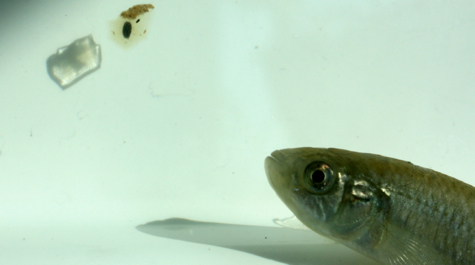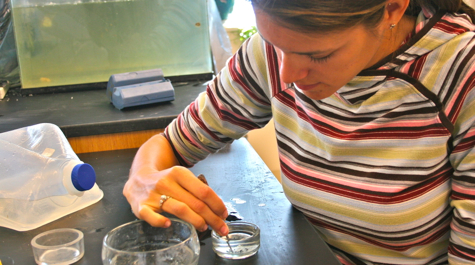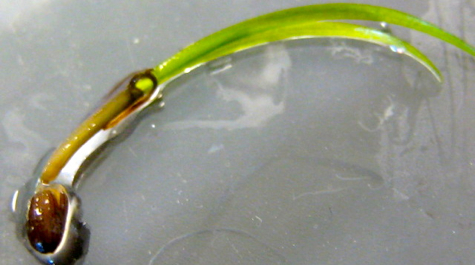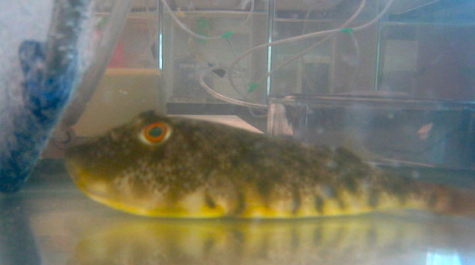Study reveals that animals contribute to seagrass dispersal
Fish, terrapins, and birds may help spread eelgrass seeds into new areas
Look out the window and you’re likely to see the dispersal of seeds—dandelion tufts in the wind, a squirrel burying an acorn, a robin flying off with a dogwood fruit. You might even have a burr “velcroed” to your sock.
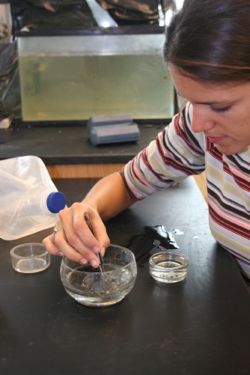
Sarah Sumoski, a recent graduate of the Virginia Institute of Marine Science, has now published a study of seed dispersal in a less-familiar environment—the eelgrass beds of Chesapeake Bay. The study—the first to show that marine animals can disperse eelgrass seeds—appears as the featured article for the December 19th issue of Marine Ecology Progress Series. It is co-authored by Dr. Robert “JJ” Orth, head of the Seagrass Monitoring and Restoration program at VIMS and Sumoski’s major professor.
Eelgrass—like other seagrasses—is a flowering plant that reproduces both by sending out rhizomes (like crabgrass) and producing tiny underwater seeds (like the fescues of many lawns). Eelgrass beds play a key ecological role in Chesapeake Bay and other coastal ecosystems but are in decline worldwide due to cloudy waters, warm temperatures, and excess nutrients that encourage the growth of light-stealing algae.
Understanding how seagrass seeds are dispersed is important for guiding efforts to restore seagrass meadows in Chesapeake Bay and other coastal ecosystems, and for informing the models that are used to guide seagrass management plans and restoration efforts.
“Traditional thinking is that eelgrass disperses by abiotic mechanisms such as floating seeds, floating reproductive shoots, or currents pushing seeds along the seafloor,” says Sumoski. “Our study shows that eelgrass seeds can also be dispersed through consumption and excretion by fish, terrapins, and birds—providing a means to bring seeds to isolated areas unlikely to receive seeds via abiotic mechanisms. In fact, we think the distance a seed travels via biotic dispersal may rival or exceed the distances recorded from abiotic mechanisms.”
Sumoski and Orth conducted the study through 3 years of painstaking laboratory experiments in which they fed 1,707 eelgrass seeds to animals often found in and around eelgrass beds—3 fish species (northern puffers, pinfish, and mud minnows or mummichogs), diamondback terrapins, and a seabird, the lesser scaup. Previous studies have recovered eelgrass seeds from the stomachs of these or similar species, and all 5 have been observed feeding in eelgrass beds, making deliberate or inadvertent ingestion of eelgrass seeds likely.
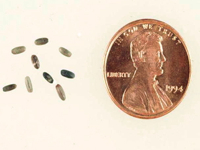
Sumoski then retrieved seeds—each smaller than a rice grain—from the animals’ feces, noted their condition, and planted intact seeds in experimental tanks containing sediments and water from the York River near VIMS’ riverside campus in Gloucester Point, Virginia.
The results of their experiments showed that the seeds were able to survive passage through the gut of all the animals studied, with excretion and germination rates highest for mummichogs and northern puffers, moderate for pinfish and diamondback terrapins, and lowest for scaup.
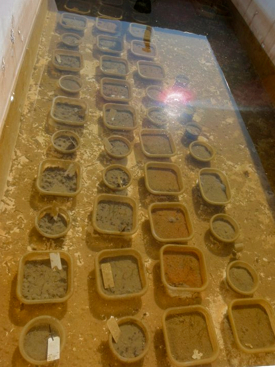 They also calculated how far the animals might be able to
carry the seeds, by measuring how long it took the seeds to pass through the
gut of each species, and multiplying those values by reported swimming or
flying speeds for each creature.
They also calculated how far the animals might be able to
carry the seeds, by measuring how long it took the seeds to pass through the
gut of each species, and multiplying those values by reported swimming or
flying speeds for each creature.
“We estimate that the fishes could disperse eelgrass seeds 10s to 100s of meters, while the maximum dispersal distance for terrapins is around 1,500 meters, or about a mile,” says Sumoski. “The scaup was the champ, with a maximum dispersal distance of more than 10 miles.”
The field data demonstrating terrapins as seed dispersers were derived from an ongoing study by VIMS graduate student Diane Tulipani, which includes the first field evidence of terrapins incidentally ingesting eelgrass seeds when feeding on eelgrass epifauna in the York River. Tulipani also collected the tracking data used to estimate the distance that terrapins can travel, and provided terrapin specimens, information on terrapin prey preference, and other general assistance in support of the terrapin-feeding trials.
Physical mechanisms have been shown to disperse eelgrass seeds similar distances: 10s of meters for seeds moved along the seafloor by currents, 100s of meters for individual floating seeds, and more than 100 kilometers for intact flowering shoots, which can float on the surface for weeks and contain multiple seeds. Sumoksi points out, however, that “the animals are likely to be more effective dispersal agents, as they prefer to live under the conditions that favor seagrass growth and thus will tend to carry seeds to areas where they’ll germinate. Wind and currents can easily disperse seeds into areas unsuitable for seagrass growth.”
Sumoski adds that dispersal of seagrass seeds by animals not included in her study—such as manatees, dugongs, and green turtles—could carry seeds of seagrass species found in tropical waters for distances greatly exceeding those of abiotic mechanisms.
Overall, she says, “While seeds will suffer mortality through ingestion and digestion, some proportion can be expected to survive, germinate, and grow to adult plants, meaning that dispersion by animals can lead to re-colonization of past eelgrass meadows, or even the colonization of new habitats. That’s good news for eelgrass beds and the organisms that rely on them for habitat, nursery grounds, and food."

